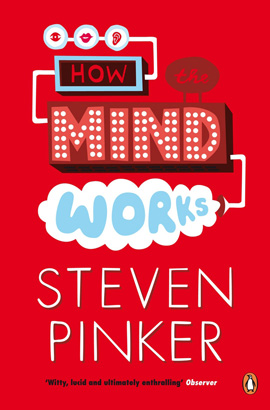Explaining how the mind works is a big topic to take on. However, if anyone is up to the challenge, I imagine Steven Pinker has to be on the shortlist.
His central premise is that the brain is a series of specialised systems. Rather than being one general problem solver, it is a collection of machines designed to do different things.
For example, we have a language module and a facial recognition module. We know this because one system can be damaged. In a condition called prosopagnosia people are unable to recognise faces. They can recognise every day objects and show no cognitive impairment, except when it comes to recognising faces, when even their own family are a mystery to them.
This is perhaps why we have been unable to recreate human intelligence with computers (though why would we, artificial intelligence is just a different kind of intelligence). It’s not that computers are too specific, following their specific code – it is that they are general problem solvers and the brain is not!
That does not mean of course that the brain cannot adapt and repurpose. If you lose the sight of an eye, for example, that part of the brain will be used up processing imagery from the other eye. However, there is design (albeit naturally guided by evolution) and purpose behind the modules of the brain.
The brain does some things really well. Colour for example. How do we know what colour snow is? It sounds easy, but it isn’t! In direct sunlight, snow reflects lots of light. Indoors, it reflects less. But it is the same thing. A camera struggles to tell. That is why you often need to set the white balance, to tell it is looking at white snow in poor light rather than grey snow in good light. The brain does all this for us though.
It takes our sensory input and presents us with the world. Tilt your head, and notice the world doesn’t move. Again, if you did this on a camera it would list. Your brain, however, keeps things steady.
Other things it is less good at though. We are not great at recognising left from right. Why? Because any rule regarding left or right had to be generalised to both sides in our hunter-gatherer evolved brain. Hence we have no problems with up and down, but often struggle with left and right.
This is all a result of the environment in which we evolved. Phobias, for example, are all things we used to be scared of. Snakes and spiders for example. You do not need to teach a monkey, or a human for that matter, to be scared of a snake – they are innate. Yet similarly, we never develop of a phobia of electricity, even though that kills far more people.
We also calibrate our happiness based on other people. Pinker claims that there is no objective measure, we just use society to gauge what can be reasonably expected and set our levels based on that. Again, it makes sense from an evolutionary perspective, that we would balance our pursuit of happiness.
This makes a case for reducing income inequality. If one person makes £50 and someone else makes £500 it is not an everybody wins situation. Of course, you have to balance that with fairness and freedom, which is difficult.
He then talks about reproduction, which is quite a depressing section. Like most animals, we use sexual reproduction. The advantage of this is that you swap half of your DNA out every generation, thus making it harder for pathogens to crack the safe as it were. Good stuff there, we all enjoy sex. However, then he talks about babies and children.
It’s a war. The baby wants as much from its mother as it can, fighting her body to draw all the nutrients into the womb. Then once it is born it fights for all the attention, trying to stop the mother from having further children as this would reduce its own attention. To an extent anyway – eventually the chance of 50% of its DNA being in a sibling becomes worth it and it gives up screaming.
Pinker also discusses the sexes in nature. Most species operate with the female bearing the offspring and therefore having the most investment in it. Therefore females tend to be most picky about selecting mates of which there are plenty of options, whereas males want to spread their DNA as far and wide as possible, and compete with each other to do so.
This has interesting social implications. For example, the idea of men being “players” and women being “sluts” is, dare I say it, natural. This does not make it moral or right of course! However, these are not social constructs, but in fact the very opposite! These are naturally occurring tendencies that we are now overcoming thanks to society.
Indeed if people could be conformed to socially constructed gender roles this would soon be selected out because the powerful men in society would force them all to be celibate and cuckolded.
He also offers an explanation for the irrationally of love. Irrationally is actually a good way to fall in love. If you did it for rational reasons, you would just leave when you found someone better, which statically speaking if you get together in the first 30 years of your life, you probably would. Therefore falling in love for irrational reasons helps nature maintain monogamous relationships.
All interesting stuff. It felt a bit disjointed at times. It wasn’t one cohesive story but then that is the point of the book. The mind is not one unified general problem solver but a series of systems.
To me, this is Pinker’s “how it works” manual while The Blank Slate is the “what the consequences of that are” book, both of them together forming the full story. It has not changed my thinking is the radical way The Blank Slate did, but it s certainly is fascinating.
If you enjoy this, you will almost certainly enjoy Dan Dennett’s Consciousness Explained too.

Don't have time to check my blog? Get a weekly email with all the new posts. This is my personal blog, so obviously it is 100% spam free.
Tags: brain, consciousness, human, mind, steven pinker
This entry was posted on Monday, July 13th, 2015 at 10:36 am and is filed under Books. You can follow any responses to this entry through the RSS 2.0 feed. Both comments and pings are currently closed.


